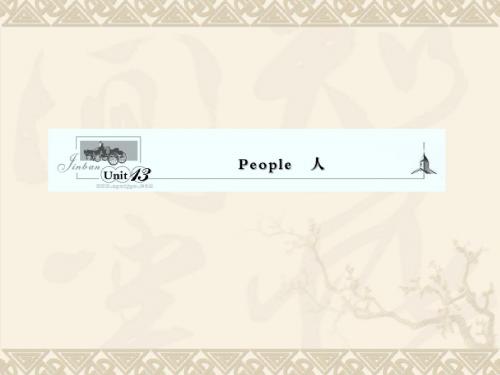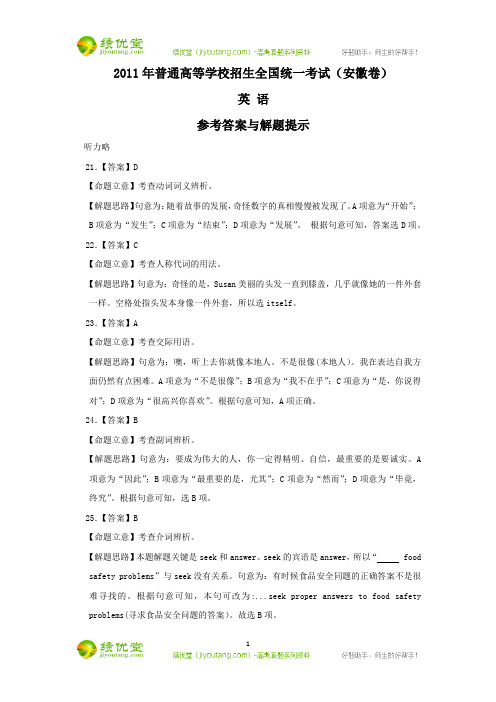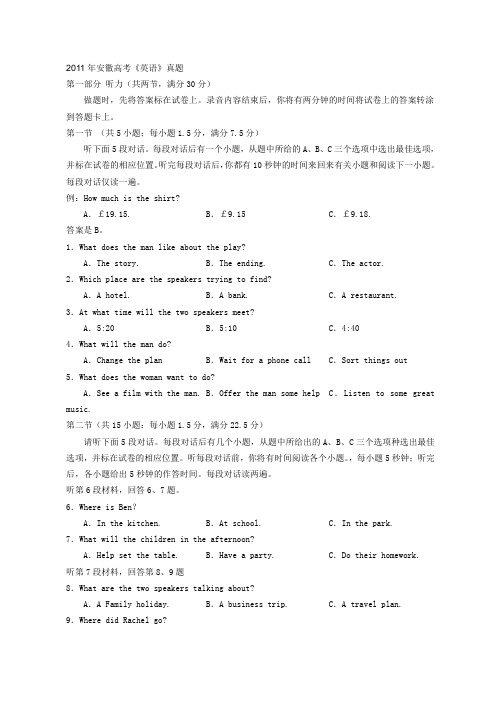安徽省2011届高三英语一轮复习:动名词
- 格式:doc
- 大小:503.00 KB
- 文档页数:2



2011年普通高等学校招生全国统一考试(安徽卷)英语参考答案与解题提示听力略21.【答案】D【命题立意】考查动词词义辨析。
【解题思路】句意为:随着故事的发展,奇怪数字的真相慢慢被发现了。
A项意为“开始”;B项意为“发生”;C项意为“结束”;D项意为“发展”。
根据句意可知,答案选D项。
22.【答案】C【命题立意】考查人称代词的用法。
【解题思路】句意为:奇怪的是,Susan美丽的头发一直到膝盖,几乎就像她的一件外套一样。
空格处指头发本身像一件外套,所以选itself。
23.【答案】A【命题立意】考查交际用语。
【解题思路】句意为:噢,听上去你就像本地人。
不是很像(本地人)。
我在表达自我方面仍然有点困难。
A项意为“不是很像”;B项意为“我不在乎”;C项意为“是,你说得对”;D项意为“很高兴你喜欢”。
根据句意可知,A项正确。
24.【答案】B【命题立意】考查副词辨析。
【解题思路】句意为:要成为伟大的人,你一定得精明、自信,最重要的是要诚实。
A 项意为“因此”;B项意为“最重要的是,尤其”;C项意为“然而”;D项意为“毕竟,终究”。
根据句意可知,选B项。
25.【答案】B【命题立意】考查介词辨析。
【解题思路】本题解题关键是seek和answer。
seek的宾语是answer,所以“ food safety problems”与seek没有关系。
句意为:有时候食品安全同题的正确答案不是很难寻找的。
根据句意可知,本句可改为:...seek proper answers to food safety problems(寻求食品安全问题的答案)。
故选B项。
26.【答案】C【命题立意】考查动词的时态和语态。
【解题思路】根据对话语境可知,本题时态为将来的某种时态,且it(store shopping)和replace之间是被动关系,故选C项。
27.【答案】D【命题立意】考查主谓一致与时态。
【解题思路】根据主句中的used可知,时态为一般过去时。



2011年安徽高考《英语》真题第一部分听力(共两节,满分30分)做题时,先将答案标在试卷上。
录音内容结束后,你将有两分钟的时间将试卷上的答案转涂到答题卡上。
第一节(共5小题;每小题1.5分,满分7.5分)听下面5段对话。
每段对话后有一个小题,从题中所给的A、B、C三个选项中选出最佳选项,并标在试卷的相应位置。
听完每段对话后,你都有10秒钟的时间来回来有关小题和阅读下一小题。
每段对话仅读一遍。
例:How much is the shirt?A.£19.15. B.£9.15 C.£9.18.答案是B。
1.What does the man like about the play?A.The story. B.The ending. C.The actor.2.Which place are the speakers trying to find?A.A hotel. B.A bank. C.A restaurant.3.At what time will the two speakers meet?A.5:20 B.5:10 C.4:404.What will the man do?A.Change the plan B.Wait for a phone call C.Sort things out 5.What does the woman want to do?A.See a film with the man. B.Offer the man some help C.Listen to some great music.第二节(共15小题:每小题1.5分,满分22.5分)请听下面5段对话。
每段对话后有几个小题,从题中所给出的A、B、C三个选项种选出最佳选项,并标在试卷的相应位置。
听每段对话前,你将有时间阅读各个小题。
,每小题5秒钟;听完后,各小题给出5秒钟的作答时间。
每段对话读两遍。
听第6段材料,回答6、7题。
动名词和分词用法动名词是动词的一种非谓语形式,由动词+ ing构成,有一般式和完成式,主动式和被动式,否定形式为not doing,具有动词和名词的性质,在句中起名词作用,可作主语、宾语、表语和定语、状语和宾补。
(1)动名词作主语(动名词做主语谓语动词用单数)动名词作主语表示抽象动作,指一件已知的事或经验。
eg:①Driving a car on the crowded road is boring. ②Reading is my hobby.句型: It’s no use/no good doing sth 做.......没有用处/好处It’s a waste of time doing sth 做.... 浪费时间(2)常只用动名词作宾语的动词有:admit,avoid,appreciate,consider,dislike,enjoy,escape,excuse,finish,imagine,keep,mind,miss,practise, risk,resist,suggest等。
eg:①I can’t imagine marrying her. ②She managed to escape being punished.以下动词词组后面只接动名词作宾语:give up,belong to,look forward to,keep on,insist on,be busy,get down to,be devoted to,have difficulty/trouble(in),have a good/wonderful time (in)等。
eg:①I’m looking forward to hearing from you soon. ②He gave up smoking three years.(3)动名词作表语动名词作表语的时候,特别要注意:不要与正在进行时混淆。
动名词作表语,表达的是“某件事”等。
安徽省2011届高三英语一轮复习:动名词
动名词是非限定动词的一种形式,由动词原形+ing构成。
它既有动词的特征,又有名词的特征,故称。
动名词也有时态和语态的变化,如表所示(以及物动词write为例),不及物动词没有语态的变化。
时态/语态主动被动
一般式writing being written
完成式having written having been written
1. 动名词作主语、宾语和表语
1)作主语。
例如:
Fighting broke out between the South and the North. 南方与北方开战了。
2)作宾语
a. 有些动词可以用动名词作宾语。
例如:
admit 承认appreciate 感激avoid 避免complete完成consider认为delay 耽误
deny 否认detest 讨厌endure 忍受en joy 喜欢escape 逃脱fancy 想象
finish 完成imagine 想象mind 介意miss 想念postpone推迟practice 训练
re call 回忆resent 讨厌resume 继续resist 抵抗risk 冒险sugg est 建议
face 面对include 包括stan d 忍受understand 理解forgive 宽恕keep 继续例如:Would you mind turning down your radio a little, please? 你把收音机音量调小一点,好吗The squirrel was lucky that it just missed being caught. 这松鼠幸运得很,刚逃避了被逮住的厄运。
b. 有些结构后面可以用动名词作宾语或其他成分。
例如:
admit to, prefer…to, be used to, lead to, devote oneself to, object to;
stick to, no good, no use, be fond of, look forward to, be proud of;
be busy, can't help, be tired of, be capable of, be afraid of, think of ;
burst out, keep on, insist on, count on, set about...
put off be good at take up give up be successful in
3)作表语,对主语说明、解释。
例如:
Her job is washing, cleaning and taking care of the children. 她的工作是洗刷、清扫和照顾孩子。
比较:She is washing, cleaning and taking care of the children.
4)作定语,一般表示所修饰名词事物的用途。
例如:
a writing desk=a desk for writing 写字台
a swimming pool=a pool swimming 游泳池
有些动名词作定语,与所修饰的名词关系比较复杂。
例如:
boiling po int=a temperature point at which something begins to boil 沸点 a walking tractor=a tractor which a driver can operate while he or she is walking behind it 手扶拖拉机
2. worth 的用法
worth, worthy, worthwhile都是形容词,意为"值得"。
1) worth:be worth + n.当名词为金钱时,表示"…… 值得……"
常见的有It ’s worth while to do./ It ’s worth(some one’s)while doing
be worth doing sth."……某事值得被做"
The question is not worth discussing again and again. 这问题不值得反复讨论。
2) worthy:be worthy of +n.当名词为抽象名词时表示"……值得……"
be worthy to be done "某事值得被做"
The que stion is not worthy to be discussed again and again.
3) worthwhile:be worthwhile to do sth"值得做某事"
It is worthwhile to ask him to join the club.值得邀请他加入俱乐部。
典型例题
It is not ____ to discuss the question again and again.
A. worth
B. worthy
C. worthwhile
D. worth while
答案C. 由worth的用法可知,此句只适合词组be worthwhile to do sth.。
选C。